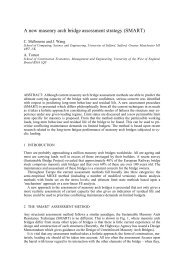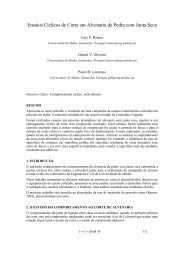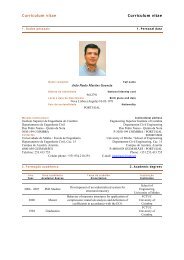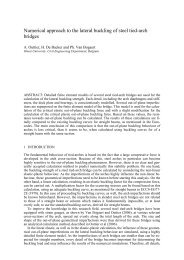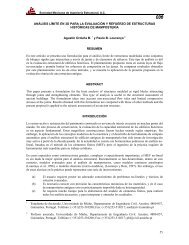an orthotropic continuum model for the analysis of masonry structures
an orthotropic continuum model for the analysis of masonry structures
an orthotropic continuum model for the analysis of masonry structures
You also want an ePaper? Increase the reach of your titles
YUMPU automatically turns print PDFs into web optimized ePapers that Google loves.
TNO-95-NM-R0712 1995 275. EXAMPLESIn <strong>the</strong> present section <strong>the</strong> <strong>masonry</strong> <strong>model</strong> proposed in this report is used to <strong>an</strong>alyse different <strong>structures</strong>found in <strong>the</strong> literature.5.1 TU Eindhoven tests on shear wallsSeveral tests on <strong>masonry</strong> shear walls were carried out within <strong>the</strong> scope <strong>of</strong> <strong>the</strong> STRUCTURALMASONRY program from <strong>the</strong> Ne<strong>the</strong>rl<strong>an</strong>ds, see Raijmakers <strong>an</strong>d Vermeltfoort (1992) <strong>an</strong>d Vermeltfoort<strong>an</strong>d Raijmakers (1993). In Louren•o (1994) some <strong>of</strong> <strong>the</strong> specimens are <strong>an</strong>alysed with a micro<strong>model</strong><strong>an</strong>d very good agreement is found with <strong>the</strong> experimental results. The parameters necessaryto characterize <strong>the</strong> micro-material <strong>model</strong> are available from micro-experiments but almost noexperimental data are available on <strong>the</strong> behaviour <strong>of</strong> <strong>the</strong> composite.The purpose <strong>of</strong> this report is not a sharp reproduction <strong>of</strong> <strong>the</strong> experimental results <strong>an</strong>d <strong>the</strong> main concern<strong>of</strong> <strong>the</strong> author is to reproduce <strong>the</strong> behaviour observed in <strong>the</strong> experiments. For this purpose <strong>the</strong>exact knowledge <strong>of</strong> <strong>the</strong> macro-material parameters is not capital (<strong>an</strong>d, in <strong>an</strong>y case, it is not known<strong>for</strong> this particular structure).The Þrst shear wall <strong>an</strong>alysed by Louren•o (1994) is used <strong>for</strong> comparison between <strong>the</strong> micro- <strong>an</strong>dmacro-<strong>model</strong>. The specimen consists <strong>of</strong> a pier with a width/height ratio <strong>of</strong> one (990 × 1000 mm 2 ),built up with 18 layers (16 layers unrestrained) <strong>of</strong> Joosten solid clay bricks (dimensions 204 x 98 x50 mm 3 ) <strong>an</strong>d 10 mm thick mortar (1:2:9, cement:lime:s<strong>an</strong>d by volume). The pier was subjected toa vertical precompression <strong>for</strong>ce P = 30 kN be<strong>for</strong>e a horizontal load was monotonically increasedunder top displacement control d until failure (see Fig. 23). The cracking patterns are depicted inFig. 24 <strong>for</strong> <strong>the</strong> two tests carried out.Pda) Phase 1 - Vertical loading b) Phase 2 - Horizontal loadingFig. 23 - Loads <strong>for</strong> Vermeltfoort shear wall


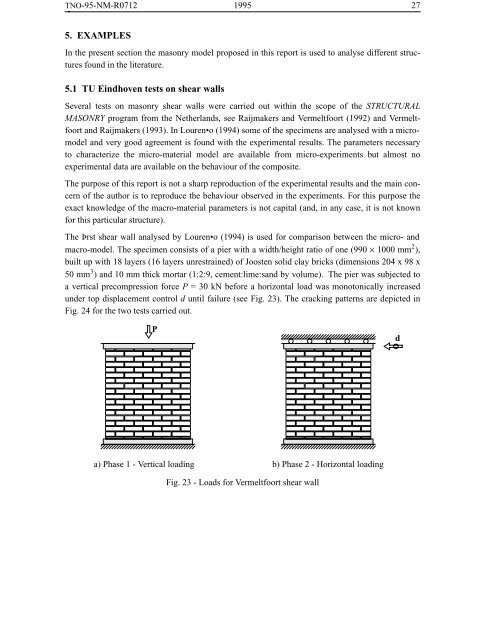
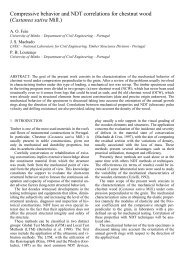
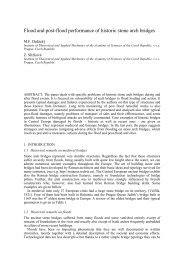
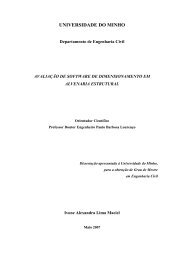

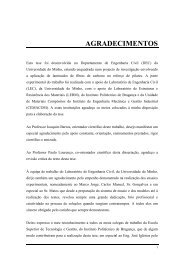

![Weibull [Compatibility Mode]](https://img.yumpu.com/48296360/1/190x134/weibull-compatibility-mode.jpg?quality=85)

